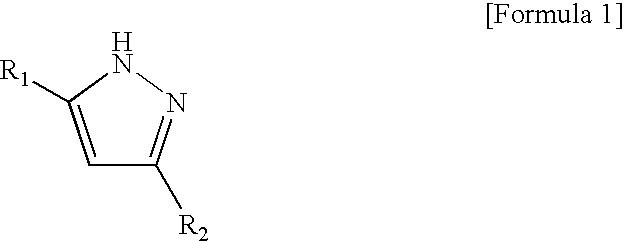Novel block polyisocyanate and urethane composition containing the same
- Summary
- Abstract
- Description
- Claims
- Application Information
AI Technical Summary
Benefits of technology
Problems solved by technology
Method used
Image
Examples
production example 1
Production of Polyisocyanate
[0062]After purging the inside of a four-necked flask equipped with a stirrer, a thermometer, a reflux condenser pipe, a nitrogen blowing pipe and a dropping funnel with nitrogen, 600 parts of HDI and 30 parts of polycaprolactone polyester triol “Placcel 303” (trade name of Daicel Chemical Industries, Ltd., molecular weight: 300), which is a trivalent alcohol, was charged therein, and the pre-reaction was carried out by maintaining the temperature in the reactor at 90° C. for one hour under stirring. Thereafter, the temperature in the reactor was maintained at 60° C. and tetramethylammonium caprylate was added as an isocyanuration catalyst. When the yield was 54%, phosphoric acid was added to stop the reaction. After filtering the reaction liquid, unreacted HDI was removed using a thin film evaporator. The resulting polyisocyanate had a viscosity at 25° C. of 9500 mPa·s, a concentration of isocyanate groups of 19.2% by mass, a number average molecular wei...
production examples 2 to 6
[0063]A polyisocyanate was produced in the same manner as in Production Example 1 except that the charging compositions and reaction conditions shown in Table 1 were applied. The characteristics of the resulting polyisocyanate are shown in Table 1.
Comparative Production Example 1
[0064]A polyisocyanate was produced in the same manner as in Production Example 1 except that the charging compositions and reaction conditions shown in Table 1 were applied. The characteristics of the resulting polyisocyanate are shown in Table 1.
Comparative Production Example 2
[0065]An HDI of 600 parts and 49 parts of a polyether polyol (SC-800, trade name of Adeka Corporation, octavalent polyol) were charged and the reaction was carried out at 160° C. for 8 hours. The production was carried out in the same manner as in Production Example 1 except that the isocyanuration reaction was not carried out. The results are shown in Table 1.
Comparative Production Example 3
[0066]The production was carried out in th...
example 1
[0067]After purging the inside of a four-necked flask equipped with a stirrer, a thermometer, a reflux condenser pipe, a nitrogen blowing pipe and a dropping funnel with nitrogen, 500 parts of the polyisocyanate obtained in Production Example 1 and 169 parts of xylene were charged and then mixed. Further, 230 parts of 3,5-dimethylpyrazole (isocyanate group / 3,5-dimethylpyrazole=1.05 (equivalent ratio)) was added and then mixed. The temperature of the resulting mixture liquid was raised to 60° C. The mixture liquid was maintained until the characteristic absorption of isocyanate group of a sample taken from the mixture liquid measured by the infrared spectral measurement disappeared.
[0068]There was obtained a blocked polyisocyanate (curing agent) of the present invention which had a solid content of 80% by mass and an blocked isocyanate group concentration of 13.4% (based on the blocked polyisocyanate).
PUM
| Property | Measurement | Unit |
|---|---|---|
| Percent by mass | aaaaa | aaaaa |
| Percent by mass | aaaaa | aaaaa |
| Percent by mass | aaaaa | aaaaa |
Abstract
Description
Claims
Application Information
 Login to View More
Login to View More - R&D
- Intellectual Property
- Life Sciences
- Materials
- Tech Scout
- Unparalleled Data Quality
- Higher Quality Content
- 60% Fewer Hallucinations
Browse by: Latest US Patents, China's latest patents, Technical Efficacy Thesaurus, Application Domain, Technology Topic, Popular Technical Reports.
© 2025 PatSnap. All rights reserved.Legal|Privacy policy|Modern Slavery Act Transparency Statement|Sitemap|About US| Contact US: help@patsnap.com

